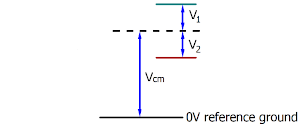Common-mode voltage and reference ground (based on differential inputs)
Common-mode voltage (Vcm) is defined as the average value of the voltages of the individual connections/inputs and is measured/specified against reference ground.

The definition of the reference ground is important for the definition of the permitted common-mode voltage range and for measurement of the common-mode rejection ratio (CMRR) for differential inputs.
The reference ground is also the potential against which the input resistance and the input impedance for single-ended inputs or the common-mode resistance and the common-mode impedance for differential inputs is measured.
The reference ground is usually accessible at or near the terminal/ box, e.g. at the terminal contacts, power contacts (cable) or a mounting rail. Please refer to the documentation regarding positioning. The reference ground should be specified for the device under consideration.
For multi-channel terminals/ boxes with resistive (=direct, ohmic, galvanic) or capacitive connection between the channels, the reference ground should preferably be the symmetry point of all channels, taking into account the connection resistances.
Reference ground samples for Beckhoff IO devices:
- Internal AGND fed out: EL3102/EL3112, resistive connection between the channels
- 0V power contact: EL3104/EL3114, resistive connection between the channels and AGND; AGND connected to 0V power contact with low-resistance
- Earth or SGND (shield GND):
- EL3174-0002: Channels have no resistive connection between each other, although they are capacitively coupled to SGND via leakage capacitors
- EL3314: No internal ground fed out to the terminal points, although capacitive coupling to SGND